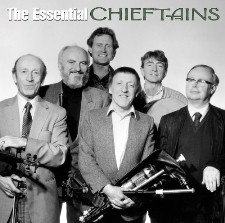For the last thirty years, The Chieftains have defined Irish music for most of the world, especially in their homeland and here in America. Formed in 1962 when Paddy Moloney rounded up several of the best folk musicians he knew in Ireland, the band slowly built a following while bandmembers kept their day jobs. The group didn’t become a full-time venture until 1975, by which time they had quietly built a worldwide audience, almost singlehandedly changing the perception of the emerald isle’s music from boisterous drinking songs and topical political screeds to poignant, complex instrumental music.
Moloney’s uilleann pipes are the distinctive element that gives The Chieftains’ music its otherworldly sound. A close cousin to the mouth-blown Scottish bagpipes, the uillean pipes are different in that the bag is inflated via a small set of bellows strapped around the waist and operated by the right arm. Because the reeds are powered by dry air, the uilleann pipes hold their pitch better than do bagpipes, and they are played sitting down, so you’re unlikely to see them in one of those kilted marching bands.
The other distinctive aspect of the band’s sound is its reliance on traditional instruments---fiddle, tin whistle, concertina, harp, flute and bodhran. There’s no guitarist, no bassist, no set of drums. Though they have constantly pushed the boundaries for lo these many years, The Chieftains are the real thing with no gimmicks.
There have been several personnel changes over the years, but the current edition of The Chieftains has played together a long time. Fiddler Sean Keane joined in 1968; rhythm maker Kevin Conneff took over the bodhran chair in 1976, also adding his vocal talents to the mix; flutist Matt Molloy is the new kid on the block, signing on in 1979. Along with leader Moloney, they’ll bring a bit of the green with them for St. Patrick’s Day week with a concert at Christopher Newport University’s Ferguson Center for the Arts on Tuesday, March 14.
 RCA/Legacy has also just released a new double disc compilation called The Essential Chieftains. It’s a beaut, capturing not only some of the best tracks the guys have laid down over the years, but also emphasizing the collaborations that have kept their music fresh and interesting for forty albums.
RCA/Legacy has also just released a new double disc compilation called The Essential Chieftains. It’s a beaut, capturing not only some of the best tracks the guys have laid down over the years, but also emphasizing the collaborations that have kept their music fresh and interesting for forty albums.
Disc 2 showcases the band in combination with a who’s who of folk, country, bluegrass and rock---“I Know My Love” with The Corrs is magnificent, Van Morrison turns in a distinctive “Shenandoah,” Buddy and Julie Miller take The Chieftains on a tour of Appalachia with “Country Blues,” Linda Ronstadt and Los Lobos take them south of the border on “Guadalupe,” and Ricky Skaggs teaches them all about bluegrass on “Cotton Eyed Joe.” Alison Krauss is simply angelic on “Molly Ban.”
But it’s still the music The Chieftains make by themselves that most impresses, and that’s what Disc 1 is all about. It’s like the soundtrack of a mythic, mystical trip through the Celtic countryside, with no extraneous touristy diversions, just the beauty and magic of the land and its music.
And that’s what will be on full display next Tuesday at the Ferguson. There’ll be no need for green beer or plastic shamrocks, and no drunken, off-key “Danny Boys” are likely to sneak into the setlist. But a visit from The Chieftains does promise to be a spirited evening of sheer musical joy, and, yes, they are bringing some friends along.
Gifted Irish harpist Triona Marshall is sitting in with the band for this tour, filling the shoes of longtime mainstay Derek Bell, who died in 2002, and to whom the Grammy nominated Live in Dublin was dedicated. Vocalist Jeff White, who appeared on that album is along as well, as is the acrobatic Canadian dancing team, Jon and Nathan Piltzke, and a teenaged musical quartet from Nova Scotia, The Cottars.
It may be three days early, but it’s hard to think of a better way to kick off this year’s St. Patrick’s Day celebration.
copyright © 2006 Port Folio Weekly. Used by Permission.

